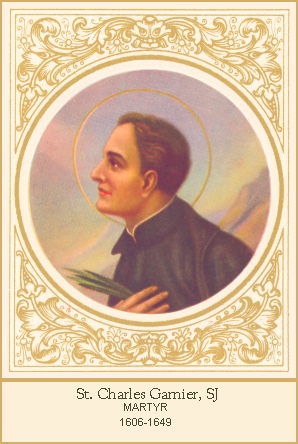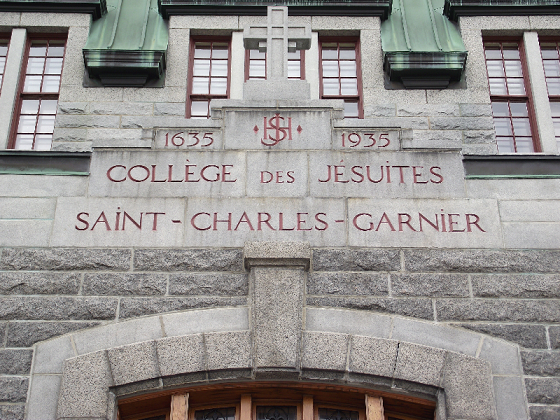St Charles Garnier, SJ
Born : May 25, 1606
Died : Dec 7, 1649
Beatified : Jun 21, 1925
Canonised : Jun 29, 1930
 St Charles Garnier was born in Paris of wealthy family. He received an excellent education and at 18 entered the Jesuit novitiate in Paris and studied philosophy and theology at Clermont College in Paris. After his ordination in 1635, he immediately requested to go to the Indian mission in North America. However his request was denied because of his father’s protest. A year later his father yielded to his request and he was appointed to the Huron mission together with other missionaries, one of whom was Fr Isaac Jogues.
St Charles Garnier was born in Paris of wealthy family. He received an excellent education and at 18 entered the Jesuit novitiate in Paris and studied philosophy and theology at Clermont College in Paris. After his ordination in 1635, he immediately requested to go to the Indian mission in North America. However his request was denied because of his father’s protest. A year later his father yielded to his request and he was appointed to the Huron mission together with other missionaries, one of whom was Fr Isaac Jogues.
The French vessel carrying the missionaries landed in Quebec two months later and Fr Garnier made his way to the Three Rivers to meet the flotilla of Huron traders who were on their way to Ihonatiria in Huronia where he was warmly greeted by Fr John de Brebeuf. In his first letter to his father, Fr Garnier wrote: “There is no place on earth where I could be happier.”
Fr Garnier spent two years learning the Huron language from Fr Brebeuf and was assigned to the mission in Ossossane when be was fluent in it. In 1639 he and Fr Jogues were sent to the Petuns whom they found to be quite hostile to the Black Robes (missionaries) as the Hurons had accused them of causing the epidemic that swept through Huronia three years ago. They returned to Ossossane after winter, as their visit was a failure. Fr Garnier however was not discouraged; he returned to Petuns in the autumn of 1640 with Fr Pierre Pijart and finding the Petuns less hostile, decided to stay. How long he worked among them is not known, but it was recorded that from 1644 to 1646 he was with the Huron Christians at Saint-Ignace and he and Fr Garreau went back to the Petuns and founded two missions. Finding the Petuns more responsive than on previous visits, Fr Garnier built a chapel at each station and within a short time baptized 184 Indians.
 The incursions of the Iroquois were becoming more frequent. They had martyred Fr Anthony Daniel in 1648. In Nov 1649 the Hurons reported that the Iroquois were on the warpath against the Petuns and swore to burn their villages during that winter. Fr Garnier instructed his newly arrived assistant Fr Noel Chabanel to return to HQ on Dec 5 while he himself remained, as much could still be done among the Petuns. At mid-afternoon of Dec 7, while Fr Garnier was doing his customary round of the village, the fearful shouts “ Iroquois, Iroquois!” were heard in Etarita. The attackers struck down men, women, and children. Fr Garnier rushed through the village exhorting his new converts to remain faithful to their faith and to flee, but he himself stayed behind. As he was about to enter a burning cabin to baptize the sick within, an Iroquois bullet penetrated his breast and another tore into his abdomen. When he fell to the ground the savage pounced on the priest, tore off his cassock, and left him to die in the cold. Fr Garnier regained consciousness shortly afterward and seeing a Petun brave in pain a short distance away, struggled to rise and help him. He crawled but a few feet and fell again. Once more he raised himself and advanced a few more paces towards the dying Petun, but at that moment an Iroquois warrior swooped down upon him, scalped him and plunged a tomahawk deep in his brain. Fr Garnier died in the very act of charity on the eve of the Immaculate Conception, a dogma he had vowed to defend.
The incursions of the Iroquois were becoming more frequent. They had martyred Fr Anthony Daniel in 1648. In Nov 1649 the Hurons reported that the Iroquois were on the warpath against the Petuns and swore to burn their villages during that winter. Fr Garnier instructed his newly arrived assistant Fr Noel Chabanel to return to HQ on Dec 5 while he himself remained, as much could still be done among the Petuns. At mid-afternoon of Dec 7, while Fr Garnier was doing his customary round of the village, the fearful shouts “ Iroquois, Iroquois!” were heard in Etarita. The attackers struck down men, women, and children. Fr Garnier rushed through the village exhorting his new converts to remain faithful to their faith and to flee, but he himself stayed behind. As he was about to enter a burning cabin to baptize the sick within, an Iroquois bullet penetrated his breast and another tore into his abdomen. When he fell to the ground the savage pounced on the priest, tore off his cassock, and left him to die in the cold. Fr Garnier regained consciousness shortly afterward and seeing a Petun brave in pain a short distance away, struggled to rise and help him. He crawled but a few feet and fell again. Once more he raised himself and advanced a few more paces towards the dying Petun, but at that moment an Iroquois warrior swooped down upon him, scalped him and plunged a tomahawk deep in his brain. Fr Garnier died in the very act of charity on the eve of the Immaculate Conception, a dogma he had vowed to defend.
Twelve miles away in another Petun village, Saint-Matthias, Fr Garreau saw the dark smoke rising from Etarita and knew the sad outcome. Inexplicably, the Iroquois did not continue their mad rampage and, thus, Saint-Matthias was spared. The next day, Fr Garreau and several scouts went to Etarita and found Fr Garnier’s body. They washed it in the snow, covered it, dug a shallow grave near the chapel, and recited funeral prayers as they lowered it into its resting place. In 1650, when the missionaries were leaving Huronia to return to Quebec, they took Fr Garnier’s remains with them.
